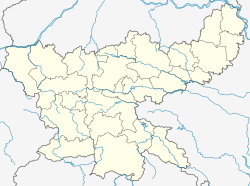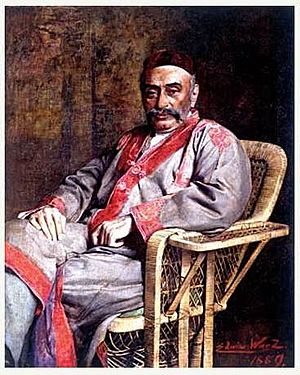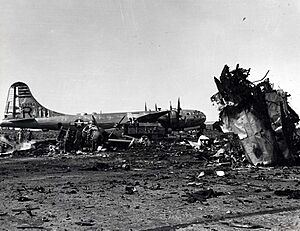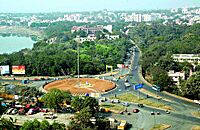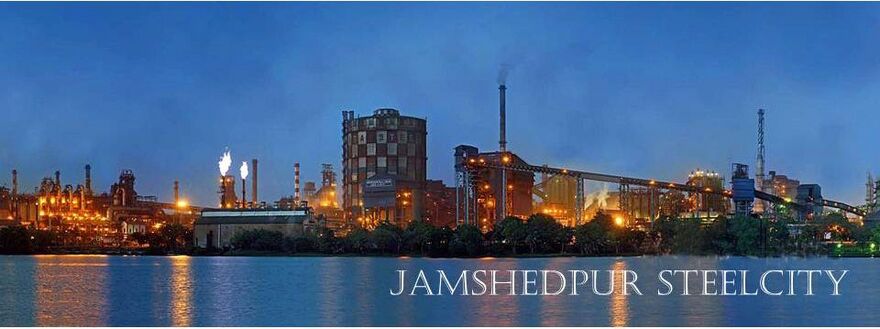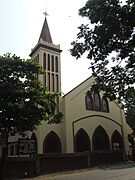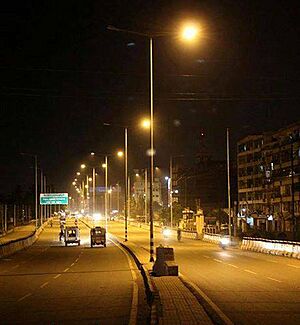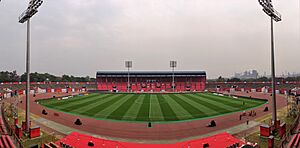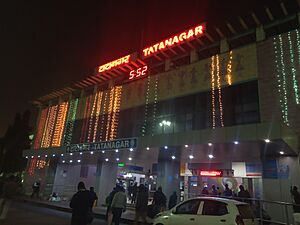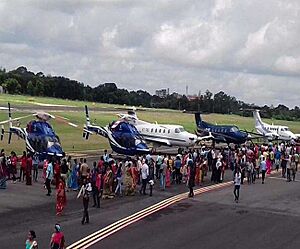Jamshedpur facts for kids
Quick facts for kids
Jamshedpur
Tatanagar
|
|
|---|---|
|
From top to bottom:
TCE Building, Sakchi view (L), Tata Steel Zoology Park (R), Golmuri Golf Course, JRD Tata Sports Complex |
|
| Nickname(s):
'Steel City of India', 'Pittsburgh of India'
|
|
| Country | |
| State | |
| District | East Singhbhum |
| Founded by | Jamsetji Tata |
| Named for | Jamshetji Tata |
| Government | |
| • Body | Jamshedpur Notified Area Committee (JNAC) |
| Area | |
| • Metropolis | 224 km2 (86 sq mi) |
| Elevation | 159 m (522 ft) |
| Population
(2011)
|
|
| • Urban | 629,659 |
| • Metro | 1,337,131 |
| Demonym(s) | Jamshedpurian |
| Languages | |
| • Official | Hindi and English |
| • Second language | Nagpuri, Bengali, Odia, Santhali, Urdu, Magahi, Bhojpuri, Tamil, Telugu, Kurmali |
| Time zone | UTC+5:30 (IST) |
| PIN |
831001 to 831xxx
|
| Telephone code | +91-657 |
| Vehicle registration | JH-05 |
| Literacy | 89.41% |
| Domestic Airport | Sonari Airport Dhalbhumgarh Airport |
Jamshedpur (/ˈdʒæmʃɛdpʊər/), also known as Tatanagar, is a big industrial city in eastern India. It is the largest city in the state of Jharkhand. It is also the third largest metropolitan area (a big city and its surrounding towns) in the region. The city itself has over 629,000 people. The wider metropolitan area is home to about 1.3 million people. Jamshedpur is located where the Swarnarekha and Kharkai rivers meet. It is surrounded by the beautiful Dalma Hills.
The modern city of Jamshedpur was started in 1912. It was named after a famous industrialist named Jamshedji Tata. He built Asia's first steel plant here and started the Tata Group. The city was important during World War I and was a key target in World War II. After India became independent, Jamshedpur became part of Bihar. In 2000, the city became part of the new state of Jharkhand.
Jamshedpur is a major business and industrial hub in India. It is known for being one of the cleanest cities in India. It also ranks high for its quality of life. The city is growing fast and is a popular place for tourists. It is one of India's first "Smart Cities." Jamshedpur is the main city of the East Singhbhum district. It is also one of the biggest cities in India by population. Jamshedpur is unique because it is a large city without a municipal corporation (a local government body).
Contents
- How Jamshedpur Got Its Name
- A Brief Look at Jamshedpur's History
- Where is Jamshedpur Located?
- How Jamshedpur is Built and Organized
- Who Lives in Jamshedpur?
- Jamshedpur's Economy
- Arts and Culture in Jamshedpur
- Learning and Education in Jamshedpur
- Sports and Fun in Jamshedpur
- News and Media in Jamshedpur
- Getting Around Jamshedpur
- Fun Places to Visit in Jamshedpur
- Famous People From Jamshedpur
- Images for kids
- See also
How Jamshedpur Got Its Name
In 1919, Lord Chelmsford officially named the city Jamshedpur. Before that, it was a village called Sakchi. The city was named to honor its founder, Jamshedji Nausserwanji Tata. His birthday, March 3, is celebrated as Founder's Day. On this day, the 225-acre (0.91 km2) Jubilee Park is lit up with amazing lights for about a week.
The city has several nicknames. People call it "Steel City" because of its steel industry. It's also known as "Tatanagar" after its railway station, Tatanagar Railway Station. Sometimes, people just call it "Tata" because of the many Tata companies there. Long ago, it was also called "Kalimati," which means "Land of Goddess Kali." This was because of a village near the Sakchi area. Sakchi became part of Jamshedpur in 1919. Today, the main road in Sakchi is still called Kalimati Road.
A Brief Look at Jamshedpur's History
How Jamshedpur Was Founded
In the late 1800s, Jamshedji Nusserwanji Tata visited steel makers in Pittsburgh. He wanted to find the best technology for his steel plant. He got the idea to build a steel plant after hearing Thomas Carlyle say that "the nation which gains control of iron soon acquires the control of gold."
Around 1900, Jamshedji Tata asked a geologist named Charles Page Perin to help him find a good spot for India's first steel plant. They started looking in April 1904 in what is now Madhya Pradesh. They needed a place rich in iron, coal, limestone, and water.
The search took almost three years. One day, they found a village called Sakchi. It was in the thick forests of the Chota Nagpur plateau, near where the Subarnarekha and Kharkai rivers meet. This seemed like the perfect spot. In 1908, building the plant and the city officially began. The first steel was made on February 16, 1912. This was a very important day for India's industries.
Jamshedpur During the World Wars
World War I started in August 1914. Steel from Jamshedpur was used in military efforts across different regions. About 1,500 miles of railway tracks and 300,000 tonnes of steel from Jamshedpur helped in these campaigns. After the war ended in 1919, Britain praised the company's help.
The city continued to grow. Jamshedji's plan for the city was very detailed. He wanted more than just simple homes for workers. He wanted to build a city with all the comforts and conveniences. This is why many areas in Jamshedpur are well-planned. There are also public places for fun, like the Jubilee Park and Dimna Lake. While planning the city, Jamshedji Tata said:
"Be sure to lay wide streets planted with shady trees, every other of a quick-growing variety. Be sure that there is plenty of space for lawns and gardens; reserve large areas for football, hockey and parks; earmark areas for Hindu temples, Muslim mosques and Christian churches."
Experts from Pittsburgh created the first layout of Jamshedpur. The city today shows how well his plans worked. In 1919, the industrial areas were combined to form Jamshedpur. Lord Chelmsford visited the city's official opening. He named it Jamshedpur to honor Jamshedji Tata and thank the company for its help in the war.
World War II began in 1945. Jamshedpur was a very important target for Japan during the war. The British government worked to protect the city from attacks. Many bomb shelters were built, and anti-aircraft guns were placed around the city. British and American troops were also brought to Jamshedpur. New airfields were built at Chakulia and Kalaikunda, with underground bunkers. Special armored vehicles, called 'Tatanagar,' were made in Jamshedpur to help with the war. Between 1940 and 1944, 4,655 Tatanagar units were produced at the railway workshop in Jamshedpur. In 1945, Tata Motors was started as "Tata Engineering & Locomotive" by buying this railway workshop.
Jamshedpur Today
In April 1979, Jamshedpur faced some community conflicts. About 108 people were killed.
In the late 1980s, the state government wanted to change how Jamshedpur was run. They proposed that the city be managed by a municipality instead of the Tata company. But the local people protested, and the government's plan was stopped. In 2005, a similar idea came up again. Many people protested, and Jamshedpur still does not have a municipal corporation.
On November 15, 2000, Jamshedpur became part of the new state of Jharkhand. The city has wide roads, shady trees, and a dam called Dimna Dam for drinking water. It also has 24-hour electricity. Many national-level schools and research centers are here. These include the Shavak Nanavati Technical Institute and the National Institute of Technology. Today, Tata Steel is India's largest private steel company. It produces 11 million tons of steel. Jamshedpur is the only city in India where a private company takes care of all the basic facilities.
Where is Jamshedpur Located?
Jamshedpur is in the southern part of the state of Jharkhand. It shares borders with the states of Odisha and West Bengal. The city is about 135 meters (443 feet) above sea level. Jamshedpur covers a total area of 224 square kilometers.
The city is mostly in a hilly area. It is surrounded by the Dalma Hills, which run from west to east and are covered with thick forests. Other smaller hills nearby include Ukam Hill and the Jadugoda-musabani hill range. Jamshedpur is also part of the larger Chota Nagpur Plateau region. The rocks in this area are very old, formed from different types of rock.
Jamshedpur is located where the Kharkai and Subarnarekha Rivers meet. The Subarnarekha is the main river in Jamshedpur. It flows from the west to the south-eastern part of the area. Many smaller rivers join the Subarnarekha river here. The Kharkai River flows from the south and joins the Subarnarekha River at a place called Domuhani. These two rivers are the main sources of drinking water for the city.
There are also several lakes near the city. The biggest ones are Dimna lake, located between the Dalma range, and the Sitarampur reservoir, next to the Kharkai River. Both of these also provide drinking water for the city. Dimna Lake is also a popular tourist spot. Jamshedpur is in a region with deciduous forests, meaning trees lose their leaves in certain seasons. About 33% of the city's land is covered in green spaces. The city is in a Seismic Zone II region, which means it has a low risk of earthquakes.
Jamshedpur has many parks. Jubilee Park in Sakchi is the largest park. It was built by Jamshedji Tata, who was inspired by the Vrindavan Gardens in Mysore.
-
Bengal tiger at Tata Steel Zoological Park
What is Jamshedpur's Climate Like?
| Climate data for Jamshedpur, India (1981–2010, extremes 1924–2009) | |||||||||||||
|---|---|---|---|---|---|---|---|---|---|---|---|---|---|
| Month | Jan | Feb | Mar | Apr | May | Jun | Jul | Aug | Sep | Oct | Nov | Dec | Year |
| Record high °C (°F) | 33.4 (92.1) |
39.4 (102.9) |
42.6 (108.7) |
45.7 (114.3) |
47.7 (117.9) |
47.2 (117.0) |
40.0 (104.0) |
38.0 (100.4) |
37.9 (100.2) |
38.2 (100.8) |
35.5 (95.9) |
33.5 (92.3) |
47.7 (117.9) |
| Mean maximum °C (°F) | 31.1 (88.0) |
35.1 (95.2) |
39.8 (103.6) |
43.2 (109.8) |
43.3 (109.9) |
41.1 (106.0) |
36.4 (97.5) |
35.8 (96.4) |
35.6 (96.1) |
35.3 (95.5) |
33.2 (91.8) |
30.7 (87.3) |
43.8 (110.8) |
| Mean daily maximum °C (°F) | 27.0 (80.6) |
30.3 (86.5) |
35.2 (95.4) |
39.2 (102.6) |
38.9 (102.0) |
36.0 (96.8) |
32.9 (91.2) |
32.6 (90.7) |
32.9 (91.2) |
32.7 (90.9) |
30.6 (87.1) |
27.7 (81.9) |
33.0 (91.4) |
| Mean daily minimum °C (°F) | 11.8 (53.2) |
15.1 (59.2) |
19.4 (66.9) |
23.8 (74.8) |
26.0 (78.8) |
26.3 (79.3) |
25.9 (78.6) |
25.8 (78.4) |
25.3 (77.5) |
22.3 (72.1) |
16.8 (62.2) |
12.4 (54.3) |
20.9 (69.6) |
| Mean minimum °C (°F) | 7.7 (45.9) |
10.5 (50.9) |
14.7 (58.5) |
19.6 (67.3) |
21.7 (71.1) |
23.2 (73.8) |
23.9 (75.0) |
24.2 (75.6) |
23.6 (74.5) |
17.7 (63.9) |
12.7 (54.9) |
8.7 (47.7) |
7.9 (46.2) |
| Record low °C (°F) | 3.9 (39.0) |
5.0 (41.0) |
10.3 (50.5) |
16.0 (60.8) |
19.0 (66.2) |
21.0 (69.8) |
21.4 (70.5) |
21.4 (70.5) |
18.7 (65.7) |
13.7 (56.7) |
6.1 (43.0) |
4.7 (40.5) |
3.9 (39.0) |
| Average rainfall mm (inches) | 11.6 (0.46) |
22.8 (0.90) |
25.0 (0.98) |
34.0 (1.34) |
78.9 (3.11) |
248.5 (9.78) |
316.5 (12.46) |
310.0 (12.20) |
232.9 (9.17) |
73.7 (2.90) |
10.3 (0.41) |
8.2 (0.32) |
1,372.4 (54.03) |
| Average rainy days | 1.3 | 1.6 | 1.8 | 2.6 | 5.2 | 10.5 | 15.4 | 15.7 | 11.3 | 4.3 | 1.0 | 0.7 | 71.4 |
| Average relative humidity (%) (at 17:30 IST) | 57 | 47 | 40 | 42 | 52 | 70 | 80 | 81 | 79 | 73 | 68 | 65 | 63 |
| Source: India Meteorological Department | |||||||||||||
Jamshedpur has been ranked as the 13th best “National Clean Air City” in India among cities with over 1 million people.
How Jamshedpur is Built and Organized
The middle part of Jamshedpur has many shops and businesses. This central area includes financial and business districts. Famous places here are Jubilee Park and Tata Steel. Sakchi and Bistupur are key business areas. This central part is also the oldest part of the city.
The western part of the city includes areas like Adityapur, Gamharia, and Sonari. Sonari is a place where people live and shop. Adityapur and Gamharia are major industrial areas. Adityapur is also a city that is part of Jamshedpur. Gamharia has an industrial area called Industrial Area, Gamharia. Adityapur has the Adityapur Industrial Area.
Five national highways cross the city. The Mango Bridge connects the city center to Mango. Marine Drive is a popular road with nice views. It starts from Sonari and connects to Adityapur.
NIT Jamshedpur is located in Adityapur. The southern part of Jamshedpur has areas like Jugsalai, Birsanagar, Kadma, Burmamines, TELCO Colony, Bagbera Colony, and Jojobera. Jugsalai is a commercial area known for its wholesale market. Birsanagar, Kadma, and Bagbera have both homes and businesses. Burmamines, TELCO Colony, Bagbera Colony, and Jojobera are other important industrial areas. Most parts of Jamshedpur have at least one industrial area.
Other tall buildings include the TCE Building and Voltas House. Many new tall buildings are being built in Jamshedpur. The tallest new building will be Ashiana Garden Sunflower Block in Adityapur. These tall buildings are mostly in the central and western parts of the city. Jamshedpur has buildings that are 10 to 14 floors high.
Neighborhoods of Jamshedpur
Who Lives in Jamshedpur?
Population Growth in Jamshedpur
| Historical population | ||
|---|---|---|
| Year | Pop. | ±% |
| 1911 | 5,672 | — |
| 1921 | 57,360 | +911.3% |
| 1931 | 83,738 | +46.0% |
| 1941 | 148,711 | +77.6% |
| 1951 | 218,162 | +46.7% |
| 1961 | 303,516 | +39.1% |
| 1971 | 356,783 | +17.5% |
| 1981 | 457,061 | +28.1% |
| 1991 | 478,950 | +4.8% |
| 2001 | 612,534 | +27.9% |
| 2011 | 629,659 | +2.8% |
| Source: Census of India | ||
According to the 2011 census of India, the city of Jamshedpur had 629,659 people. But the larger Jamshedpur Urban Agglomeration (city and surrounding areas) had 1,337,131 people. The city is called a "Million Plus Urban Agglomeration" by the government. About 52.1% of the people are male and 47.9% are female. Jamshedpur has a high literacy rate of 89.41%, which is better than the national average of 74%. About 11.5% of the population is under six years old.
The Jamshedpur Urban Agglomeration includes: Jamshedpur (Industrial Town), Jamshedpur (NAC), Tata Nagar Railway Colony (OG), Mango (NAC), Jugsalai (M), Bagbera (CT), Chhota Gobindpur (CT), Haludbani (CT), Sarjamda (CT), Gadhra (CT), Ghorabandha (CT), Purihasa (CT), Adityapur (M Corp.), Chota Gamahria (CT) and Kapali (CT).
Jamshedpur grew from a small rural area into a busy city because of the Tata Iron and Steel Company Limited, started in 1907. Its population grew a lot after 1921, mainly because many people moved there. People from all over India, especially from Bihar, came to Jamshedpur to find jobs in the factories. They settled in nearby areas. This made the city's population very diverse, with many communities from places like Bhagalpur, Darbhanga, and Patna. People from other cities in Jharkhand, like Dhanbad and Ranchi, also came for work. The city also became home to refugees who arrived during the partition of India.
Languages Spoken in Jamshedpur
In Jamshedpur, six main languages are spoken by about 85% of the people. These are Hindi, Bengali, Bhojpuri, Odia, Urdu, and Punjabi. Other languages spoken include Maithili, Ho, Chhattisgarhi, Santali, Mundari, Gujarati, Tamil, Telugu, Kurukh/Oraon, Nepali, Malayalam, Marathi, Rajasthani, Sadan/Sadri, Awadhi, and Bhumij.
Religions and Groups in Jamshedpur
| Religion in Jamshedpur* (2011) | ||||
|---|---|---|---|---|
| Hinduism | 83.7% | |||
| Islam | 6.9% | |||
| Sikhism | 4.1% | |||
| Unclassified Sect. | 2.7% | |||
| Christianity | 2.2% | |||
| Jainism | 0.2% | |||
| Buddhism | 0.1% | |||
| Not stated | 0.1% | |||
Most people in Jamshedpur are Hindus. Muslims, Sikhs, and Christians also make up a large part of the population. Jains and Buddhists also live in the city. Hindus and Muslims live in almost all areas of Jamshedpur. Many Muslims are found in Maango, Sakchi, and Golmuri. Most Sikhs live in Golmuri and Sakchi. Christians are mostly found in the central part of the city. About 28% of the population are tribal people, and they live in Birsanagar, a very large area of Jamshedpur.
Jamshedpur's Economy
The biggest industry in Jamshedpur is Tata Steel. It is in the center of the city and covers about one-fifth of the entire city area. Many other industries in Jamshedpur are connected to Tata Steel. Tata Motors is the second largest industry. It covers 822 acres on the eastern side of the city. It makes medium and heavy commercial vehicles and their parts. The company also has its own town, known as Telco.
Nuvoco Vistas Corp. Ltd is a cement plant in Jojobera, Jamshedpur. It is Asia's largest cement grinding unit.
The Adityapur Industrial Area has many different and strong industries. Jamshedpur is known as the industrial capital of Jharkhand.
Arts and Culture in Jamshedpur
Cinema and Film Connections
Jamshedpur has influenced Santali, Hindi, Odia, and Bengali films. Many movies have been filmed and set in the city. It is sometimes called "Mini Mumbai" because of its strong film culture and because many film and TV artists come from here.
Some films shot in or near Jamshedpur include:
- Ritwik Ghatak's Subarnarekha (1962 Bengali film)
- Satyakam (1969 Hindi film)
- Udaan (which was also shown at the Cannes Film Festival)
- Bubble Gum
- Parts of M.S.Dhoni: The Untold Story
- Urojohaj (Bengali film by Buddhadeb Dasgupta)
- Dil Bechara
- John Abraham's Banana
Many famous entertainers are also from Jamshedpur. These include Priyanka Chopra, R. Madhavan, and Imtiaz Ali.
Learning and Education in Jamshedpur
Important schools and colleges in Jamshedpur include:
- XLRI, started in 1949, is India's oldest management institute.
- Mahatma Gandhi Memorial Medical College, started in 1961.
- National Institute of Technology, Jamshedpur, an important engineering college, started in 1960.
- The National Metallurgical Laboratory (NML), one of 38 Council of Scientific and Industrial Research (CSIR) labs, opened in 1950.
- Shavak Nanavati Technical Institute (SNTI), started in 1921 by Tata Steel, trains skilled workers for many companies. Its library has 400,000 books and is very popular.
Many high-level institutions are in Jamshedpur. There are plans to build more universities and educational places in the future.
Sports and Fun in Jamshedpur
Jamshedpur has private clubs where people can play golf, tennis, squash, billiards, ride horses, and go water scootering. Jamshedpur FC is a professional football club from Jamshedpur. It plays in the Indian Super League (ISL), which is the top football league in India. Tata Steel owns this club.
Sports Facilities and Training Centers
- JRD Tata Sports Complex: This stadium has an international-standard track and is used for football and athletics. It also has facilities for archery, basketball, field hockey, swimming, table tennis, tennis, volleyball, skating, yoga, and a modern gym. Jamshedpur FC uses this stadium as its home ground. It also hosted women's football and archery events for the 34th National Games in 2011.
- Keenan Stadium: This stadium hosted its first international cricket match in 1983. Many other international matches have been played here.
- Tata Football Academy: Started in 1987, this academy trains young Indian footballers to improve the standard of Indian football. It is one of the best football training centers in India.
- Tata Archery Academy: Archery is a traditional sport for the tribal people of Chhotanagpur and Santhal Pargana. Tata Steel has helped these local tribal people. It gives them facilities and training to become international archers. Its students have won many medals in national and international competitions.
- Tata Steel Adventure Foundation: Bachendri Pal, the first Indian woman to climb Mount Everest, is the director of this foundation.
Jamshedpur has two golf courses: the Beldih Golf Course and the Golmuri Golf Course. Both are in the middle of the city. The Beldih Golf Course is larger. Both courses host the annual Tata Open Golf Tournament. This tournament started in 2002. Jamshedpur also has the Jamshedpur Gliding Club and the Jamshedpur Co-operative Flying Club.
News and Media in Jamshedpur
Television Channels
Jamshedpur has several local news and cable TV channels, including:
- Aaj Tak
- ABP News
- 5AM
Newspapers
Newspapers in English, Santali, and Bengali are published from Jamshedpur.
Hindi newspapers
- Dainik Jagran
- Dainik Bhaskar
- Hindustan Dainik
- Prabhat Khabar
English newspapers
- The Avenue Mail
- The Town Post
Bengali Newspapers
- Khobor Kagoj
Getting Around Jamshedpur
The Tatanagar Junction is the main train station in Jamshedpur. It is part of the Chakradharpur railway division of the South Eastern Railway. Other train stations in the city include Adityapur, Gamharia, Salgajudih, Kandra, and Govindpur.
Jamshedpur is connected to other parts of India by national and state highways. The main highways are:
- National Highway 33 (NH-33): This highway passes through the city and connects it to Mumbai. It also joins NH32, which connects to Kolkata. NH-2, NH-33, and NH-6 connect it to Kharagpur and Kolkata.
- National Highway 18 (NH-18): This highway connects Jamshedpur to Dhanbad, passing through Bokaro.
- Tata-Kandra Road: Connects Jamshedpur to Kandra via Gamahria.
- Marine Drive, Jamshedpur: This road connects the Adityapur Toll Bridge to Mango. It goes through the western parts of Jamshedpur, including Kadma and Sonari.
- For local travel, people can use buses and auto-rickshaws. These are popular ways to get around.
Jamshedpur has a bus station in Mango. Buses from here go to other cities like Bokaro, Dhanbad, and Ranchi. There are plans to make this bus station newer and better.
Sonari Airport serves the city now. It covers 25 acres in the Sonari area. The airport is mainly used for private planes of the TATA group. In 2022, it was announced that Sonari Airport would start public flights to Bhubaneswar, Ranchi, and Kolkata. After efforts from the government and Tata Steel, the airport reopened on January 31, 2023. A new airline, IndiaOne Air, now offers flights to Kolkata and Bhubaneswar.
Dhalbhumgarh Airport is a planned public airport for Jamshedpur. It will be built at Dhalbhumgarh, about 60 km (37 miles) from Jamshedpur on NH-33. It will be on the site of an old World War II airfield. This old airfield was built around 1948 to help other airfields in eastern India during the war. It was used by Allied forces to fight off Japanese troops and keep transport routes open to China. The airfield was left unused after the war. In 2017, experts approved the Dhalbhumgarh site for a new airport. The government plans to invest a lot of money to build this new airport, which will have a 3 km (1.9 miles) long runway.
Fun Places to Visit in Jamshedpur
Jamshedpur has many popular places to visit, including:
- Jubilee Park: Built by Jamsetji Tata, inspired by Vrindavan Gardens of Mysore.
- Dalma Wild Life Sanctuary: A place to see wild animals.
- Dimna Lake: A man-made lake.
- Tata Steel Zoological Park: A zoo with many animals.
- JRD Tata Sports Complex: The home stadium for Jamshedpur FC, which hosted the 2011 National Games.
- Marine Drive, Jamshedpur: A scenic road along the water, one of the few in India.
- Dalma Hills: The hills surrounding the East Singhbhum district.
- Ghatshila: A nice spot for picnics.
- Jamshedpur Coin Museum: A museum with 1200 rare and old coins, including the world's smallest coin from 300–400 AD.
- Sumant Moolgaonkar Park: A park built near HUDCO Lake.
- Millenium Park
- The Russi Modi Centre of Excellence
Famous People From Jamshedpur
- Varun Aaron, cricketer
- Imtiaz Ali, director
- Pratyusha Banerjee, television actress
- Priyanka Chopra, Indian singer, actress and winner of Miss World 2000
- Rasika Dugal, actress
- Gerald Durrell, OBE, conservationist
- Ishita Dutta, actress
- Tanushree Dutta, former Femina Miss India and actress
- Adarsh Gourav, actor
- Ishank Jaggi, cricketer
- Saba Karim, cricketer
- Kamlesh Kumar, teacher and social activist
- R. Madhavan, actor
- Manmohan, actor
- Shomu Mukherjee, filmmaker
- Gourav Mukhi, footballer
- Shweta Prasad, actress
- Arshadul Qadri, scholar
- K. V. P. Rao, cricketer
- Shilpa Rao, singer
- Randhir Singh, cricketer
- Simone Singh, Indian television actress
- Akshat Singh, YouTuber
- Saurabh Tiwary, cricketer
Images for kids
See also
 In Spanish: Jamshedpur para niños
In Spanish: Jamshedpur para niños









